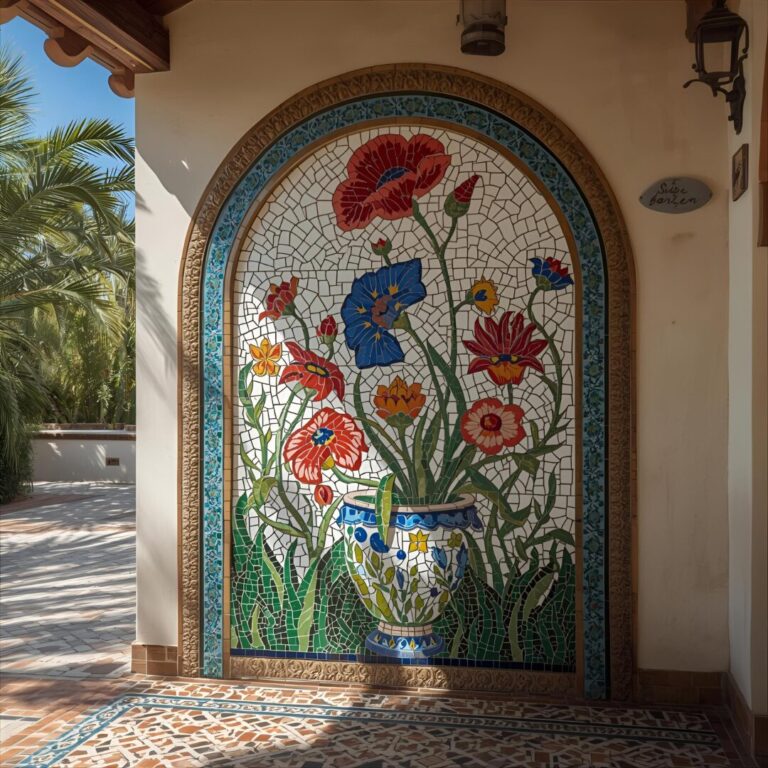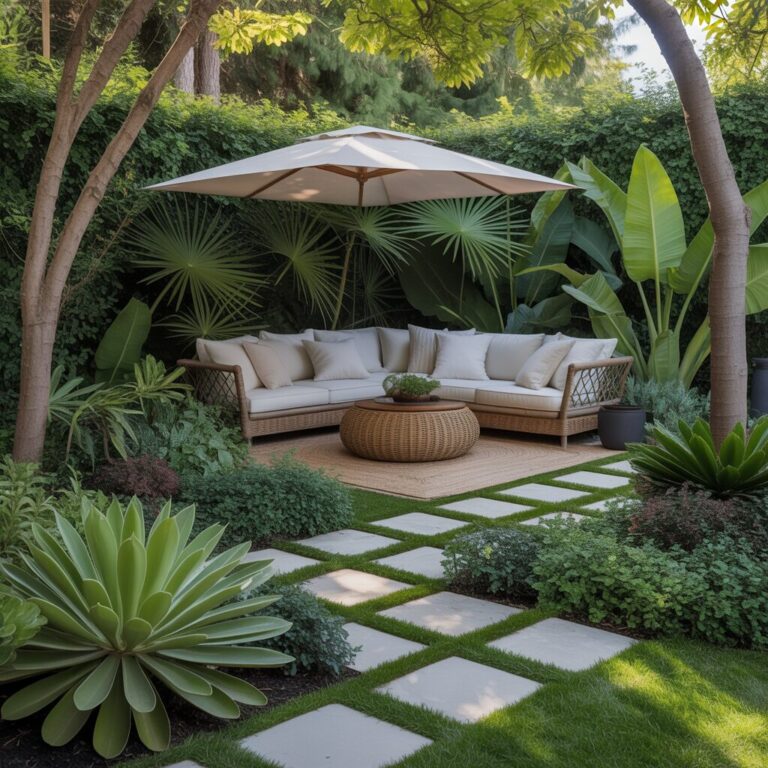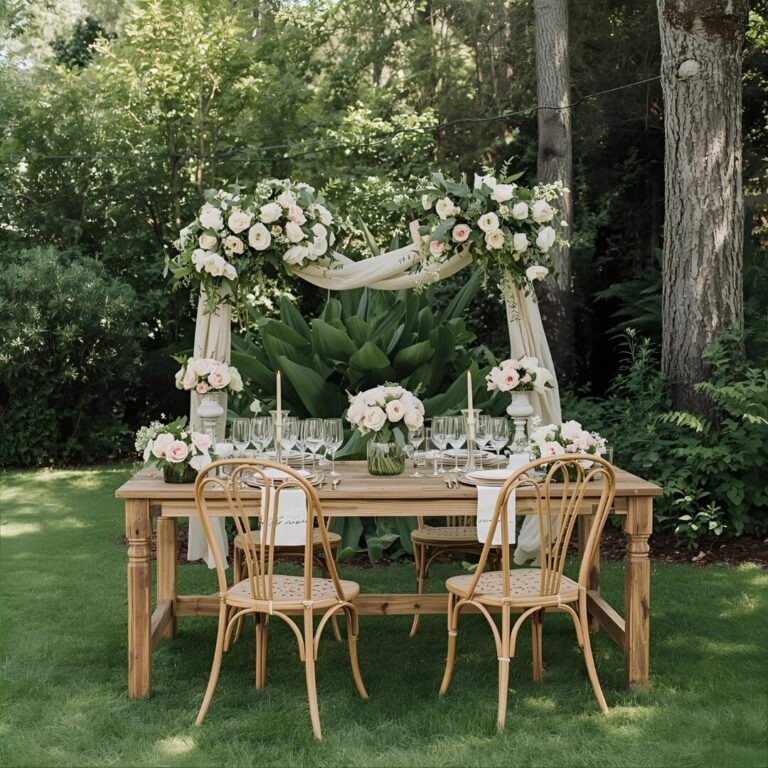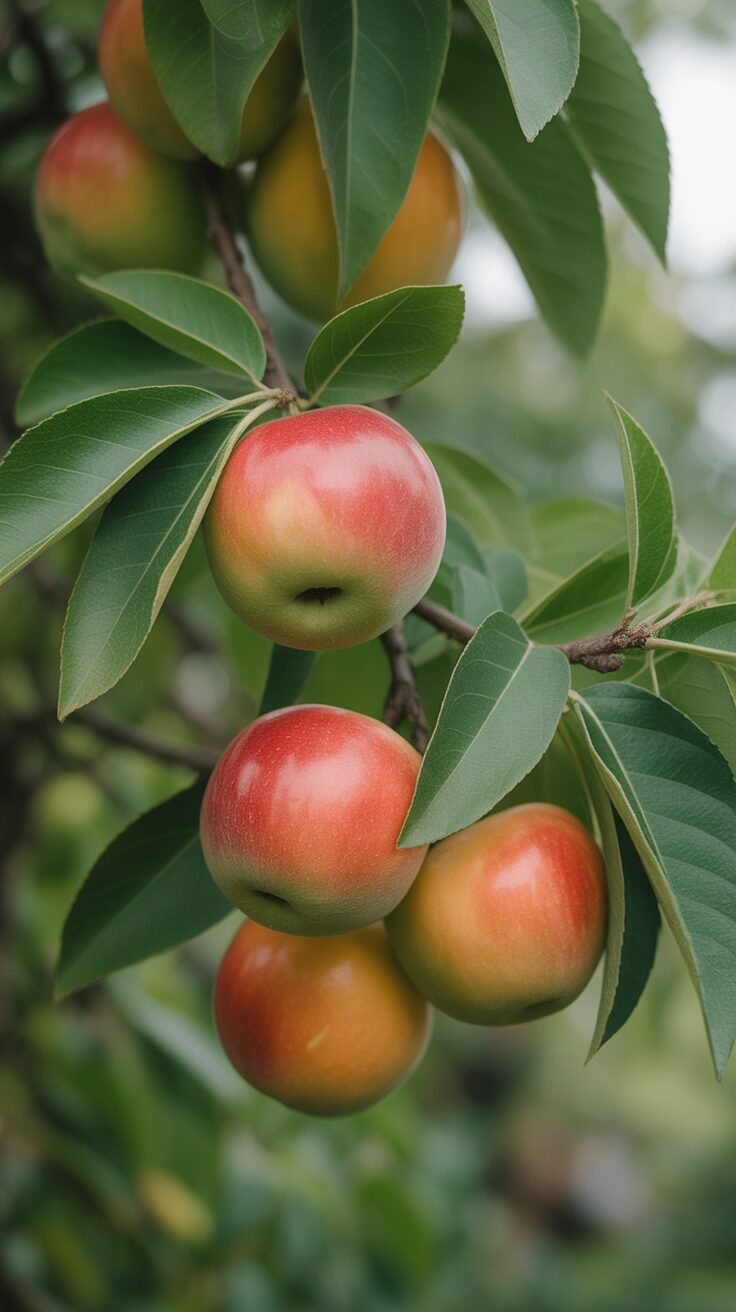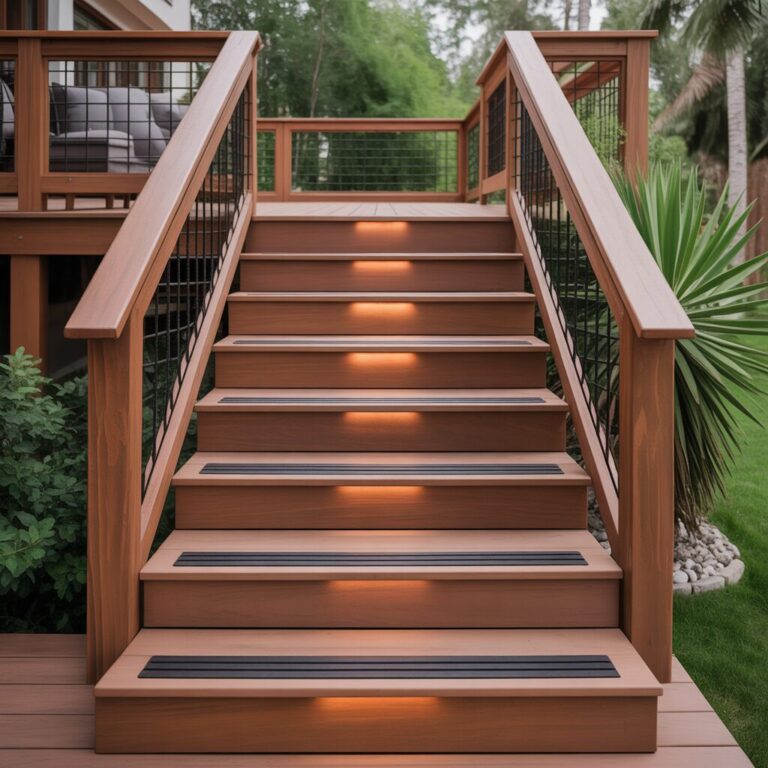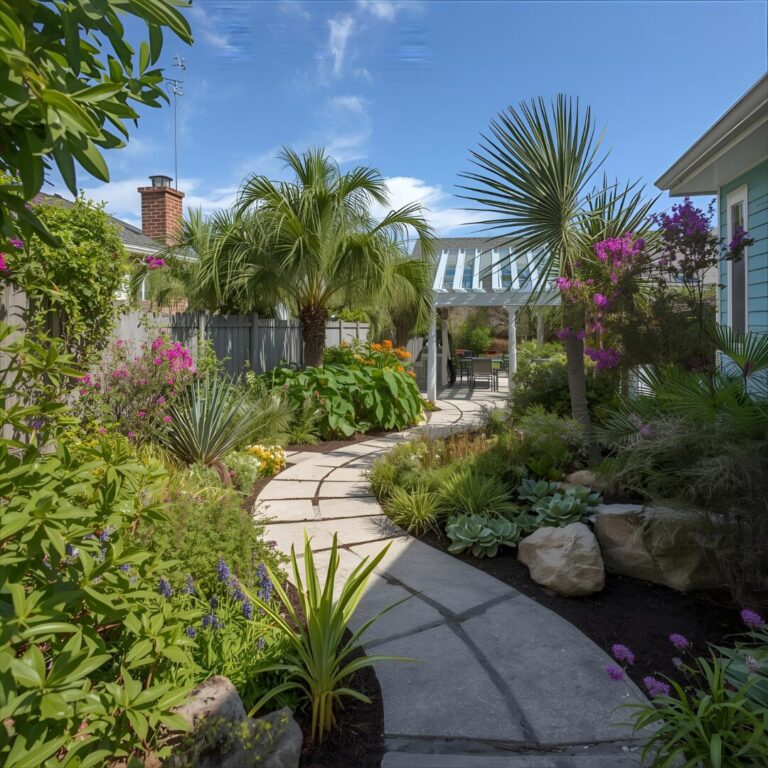11 Bushes In Front Of House Ideas That Boost Curb Appeal
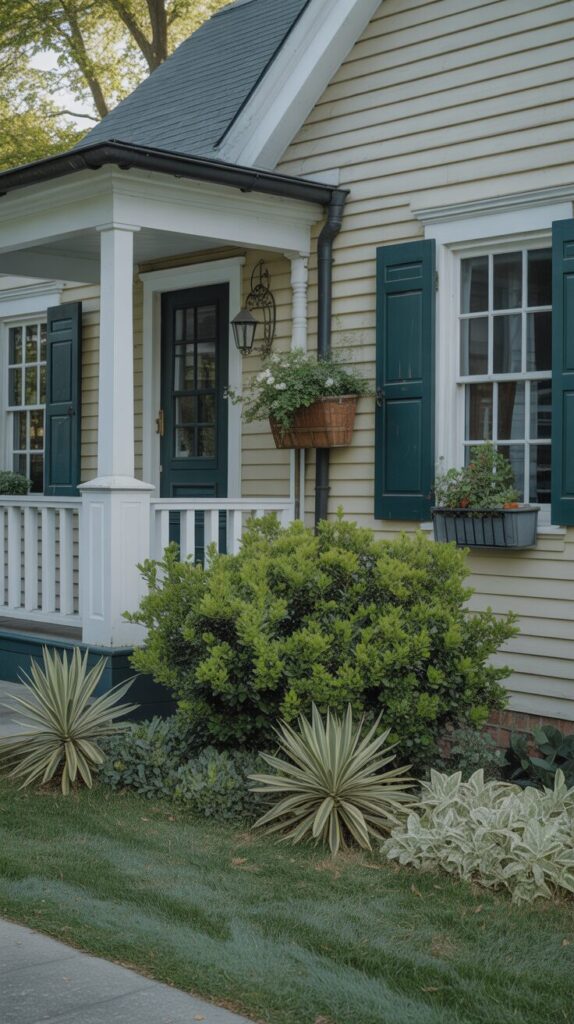
Foundation plantings featuring well-chosen Bushes In Front Of House Ideas dramatically transform your home’s exterior appearance, creating polished curb appeal that welcomes visitors and increases property value significantly and immediately. These strategically placed shrubs soften harsh architectural lines, add color and texture throughout seasons, provide privacy and structure, and frame your home beautifully without overwhelming its architectural features. Selecting the right bushes for your front yard requires considering mature size, maintenance needs, growing conditions, seasonal interest, and how they complement your home’s style and surrounding landscape elements. Whether you prefer classic formal hedges, colorful flowering shrubs, low-maintenance evergreens, or modern minimalist plantings, the right foundation bushes create cohesive outdoor design that enhances your home’s beauty year-round. These living elements provide the essential transition between hard architectural structures and soft lawn areas, grounding your home visually while adding dimension and natural beauty that changes with seasons. Discover eleven stunning ideas for bushes in front of your house that will inspire you to elevate your home’s curb appeal through thoughtful, beautiful landscaping choices.
1. Classic Boxwood Foundation Hedge
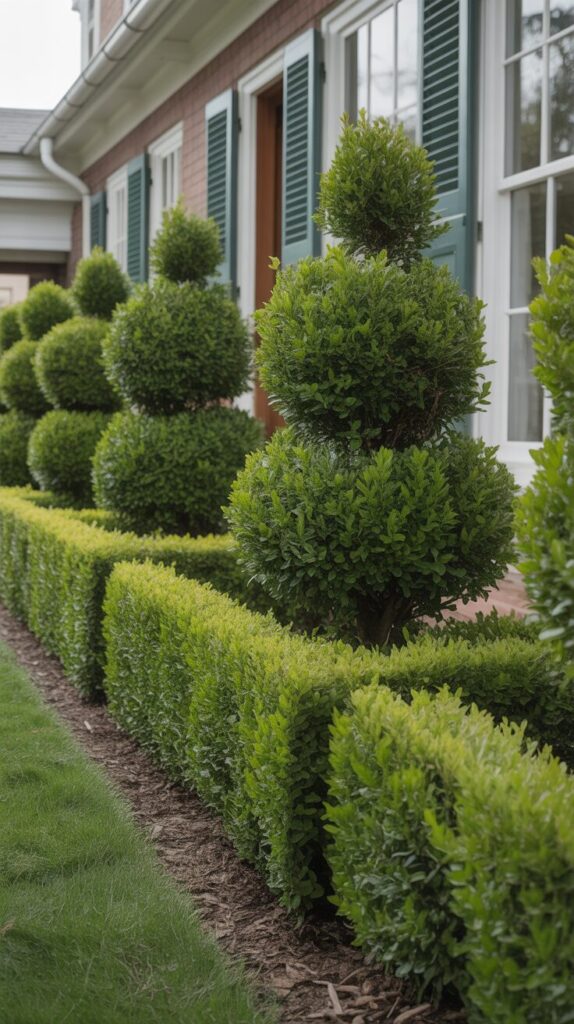
Plant traditional boxwood shrubs along your home’s foundation in a neat, formal hedge that provides timeless elegance, year-round green color, and sophisticated structure that complements any architectural style beautifully. Choose varieties like ‘Green Velvet’ or ‘Winter Gem’ that maintain compact size, resist winter damage, and tolerate shearing well for maintaining precise formal shapes throughout growing seasons consistently. Space boxwoods 2-3 feet apart for hedge effect, or use them as individual rounded specimens flanking entryways, corners, or windows for more informal yet still structured foundation plantings. The dense evergreen foliage provides privacy screening at eye level, creates clean architectural lines, and requires moderate maintenance including annual shearing to maintain desired shape and size throughout years. This classic choice works particularly well with traditional, colonial, or formal architecture, offering proven reliability and timeless beauty that never goes out of style or appears dated over time.
2. Colorful Hydrangea Border – Bushes In Front Of House Ideas
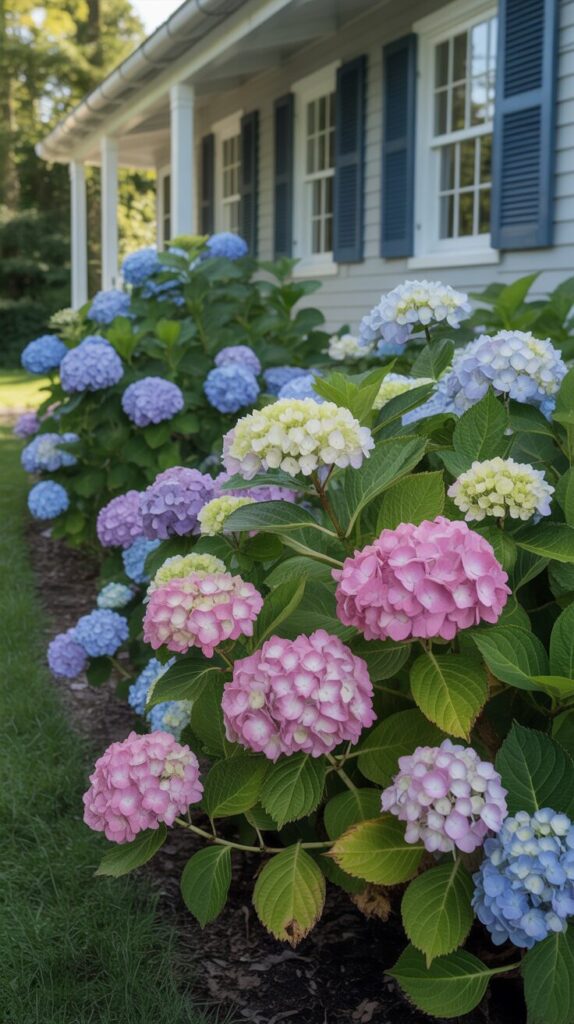
Create stunning seasonal interest with hydrangeas planted along your foundation, providing enormous flower clusters in blues, pinks, whites, or purples that create dramatic summer color displays visitors will remember. Select varieties suited to your climate and sun exposure—mophead hydrangeas for traditional rounded blooms, lace cap for delicate appearance, or panicle hydrangeas for cone-shaped white flowers that change to pink. Plant hydrangeas with 3-4 feet spacing to allow proper air circulation and room for their mature spread, positioning them away from house walls to prevent moisture issues and ensure adequate growing space. These deciduous flowering shrubs bloom from early summer through fall, providing months of color while their interesting branching structure offers winter interest even after leaves drop seasonally and reliably. Hydrangeas work beautifully with cottage, farmhouse, or traditional architecture, adding romantic charm and substantial visual impact that transforms bland foundations into flowering showcases worth photographing and sharing.
3. Low-Growing Juniper Groundcover
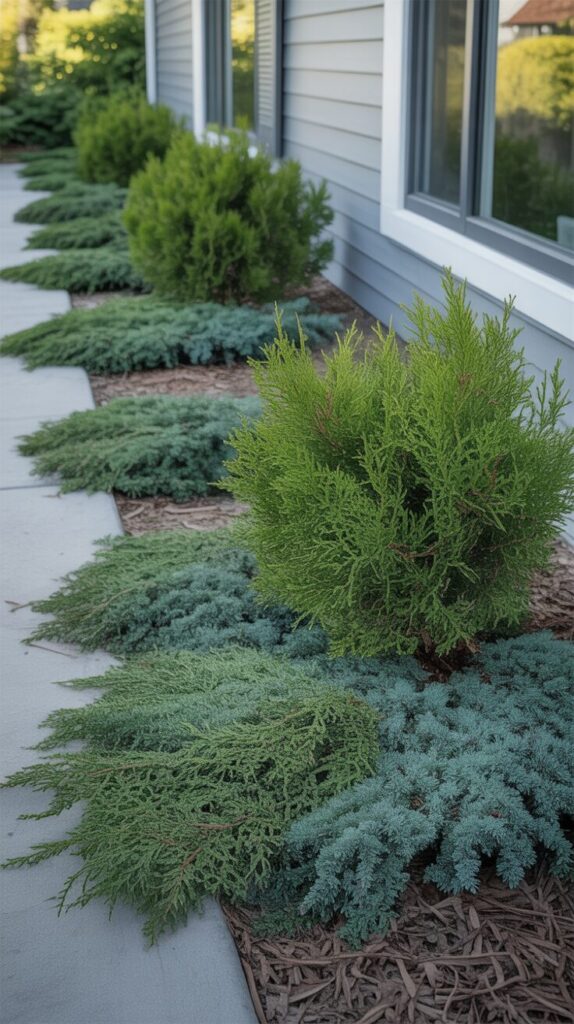
Choose prostrate or spreading juniper varieties that stay low to the ground, creating textured evergreen groundcover that requires minimal maintenance while preventing weeds and providing year-round interest at foundation level. Varieties like ‘Blue Rug’ or ‘Prince of Wales’ spread horizontally rather than growing tall, making them ideal for planting under windows where taller shrubs would block views or create maintenance challenges. The needle-like foliage adds fine texture contrasting beautifully with siding materials, comes in shades from bright green to silvery blue, and tolerates drought once established making them practical for busy homeowners. Space junipers 4-5 feet apart for groundcover effect, allowing them to spread and fill in over time while maintaining individual plant health and preventing overcrowding that causes disease. This low-maintenance option works perfectly with modern, contemporary, or ranch-style homes where clean lines and horizontal emphasis complement the architecture while the evergreen foliage provides consistent year-round color.
4. Azalea and Rhododendron Mix
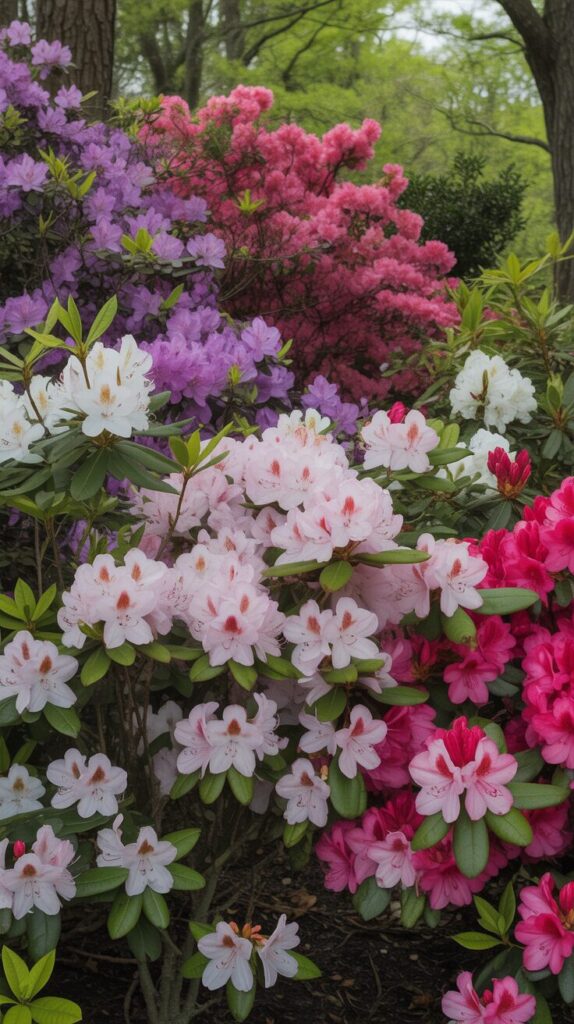
Plant masses of azaleas or rhododendrons for spectacular spring flower displays in vibrant pinks, purples, whites, or reds that create breathtaking color against your home’s exterior for several weeks annually. These acid-loving shrubs prefer partial shade and well-draining acidic soil, making them ideal for north-facing foundations or areas under tree canopy where other sun-loving shrubs might struggle to thrive. Choose evergreen varieties in warmer climates for year-round foliage, or deciduous types in colder regions where they’ll still provide stunning spring color before leaves emerge on surrounding trees and landscape. Layer different bloom times—early, mid, and late-season varieties—to extend the flowering period from early spring through early summer, maximizing the spectacular color display these shrubs provide. Azaleas and rhododendrons complement traditional, cottage, or woodland-style homes beautifully, creating the lush, layered foundation plantings that make houses feel nestled into established gardens rather than newly constructed structures.
5. Dwarf Alberta Spruce Sentinels
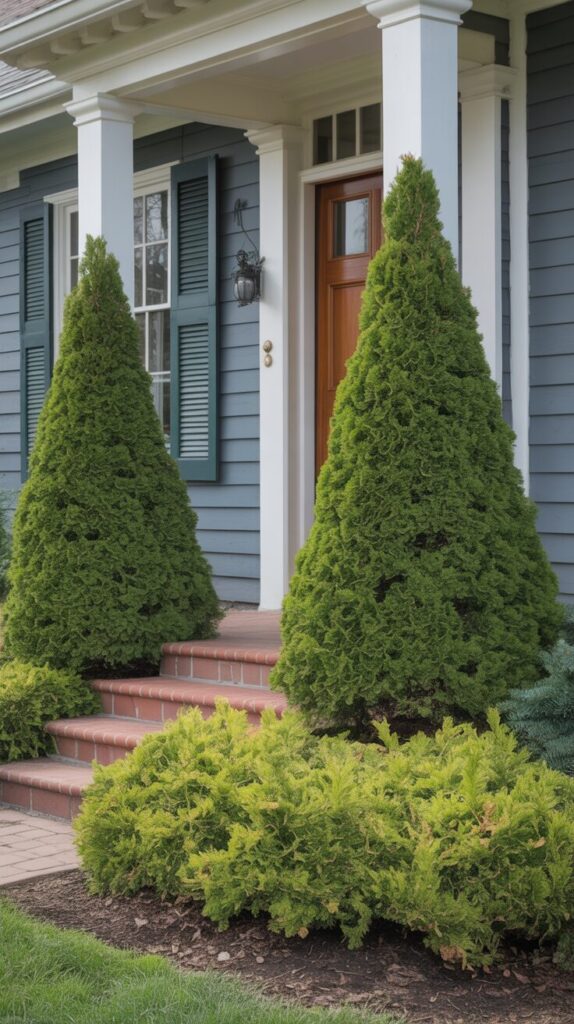
Flank your front door, corners, or windows symmetrically with dwarf Alberta spruce providing formal evergreen structure through neat conical shapes that maintain compact size without constant pruning required. These slow-growing conifers eventually reach 6-8 feet tall but take years to mature, providing long-lasting structure while their dense bright green foliage creates striking contrast against most siding colors. The naturally pyramidal shape requires no shearing to maintain form, though you can prune lightly if needed, making them ideal for homeowners seeking structured appearance without weekly maintenance commitments. Plant them in full sun to partial shade, ensuring good drainage and protection from harsh winter winds that can brown their delicate foliage causing cosmetic damage requiring corrective pruning. Dwarf Alberta spruce works particularly well with colonial, craftsman, or traditional architecture where symmetry and formal structure enhance the home’s classical proportions and architectural details beautifully and appropriately.
6. Ornamental Grass Border
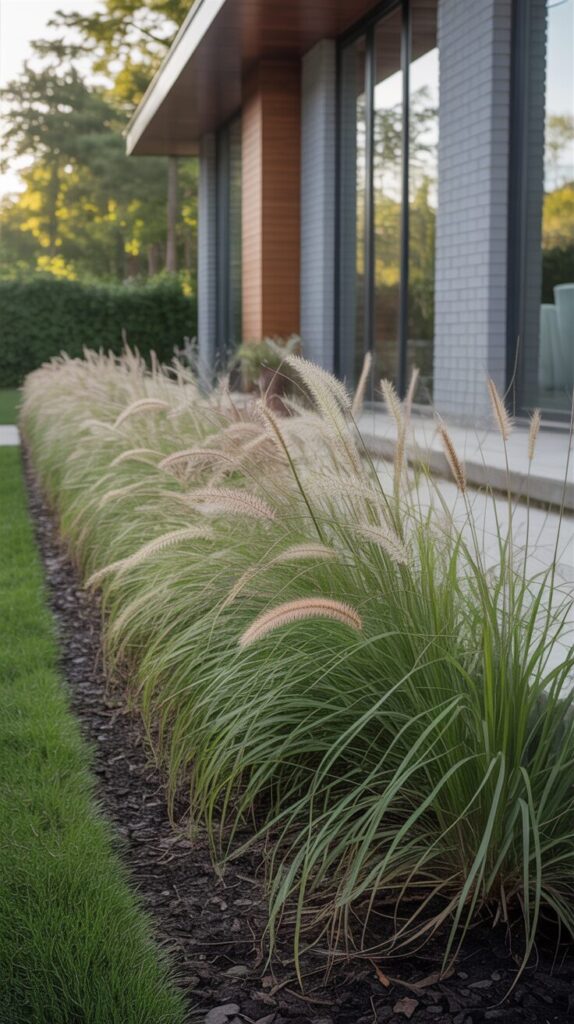
Break from traditional shrubs by planting ornamental grasses like miscanthus, fountain grass, or switch grass along your foundation for modern, textured look with movement and seasonal interest throughout. These grasses provide vertical interest, airy texture contrasting with solid house walls, and beautiful seed heads that persist through winter adding structural interest when most plants look dormant and lifeless. Choose varieties appropriate for your climate and space—compact fountain grass for smaller areas, tall miscanthus for dramatic impact, or native switch grass for eco-friendly sustainable landscaping that supports wildlife. The grasses require minimal maintenance beyond annual spring cutback, tolerate various soil conditions, and provide year-round beauty as foliage changes color through seasons from green to gold to tan. This contemporary approach works beautifully with modern, mid-century, or contemporary architecture where clean lines and natural materials create cohesive design language between house and landscape seamlessly and stylishly.
7. Rose Bushes for Romantic Charm
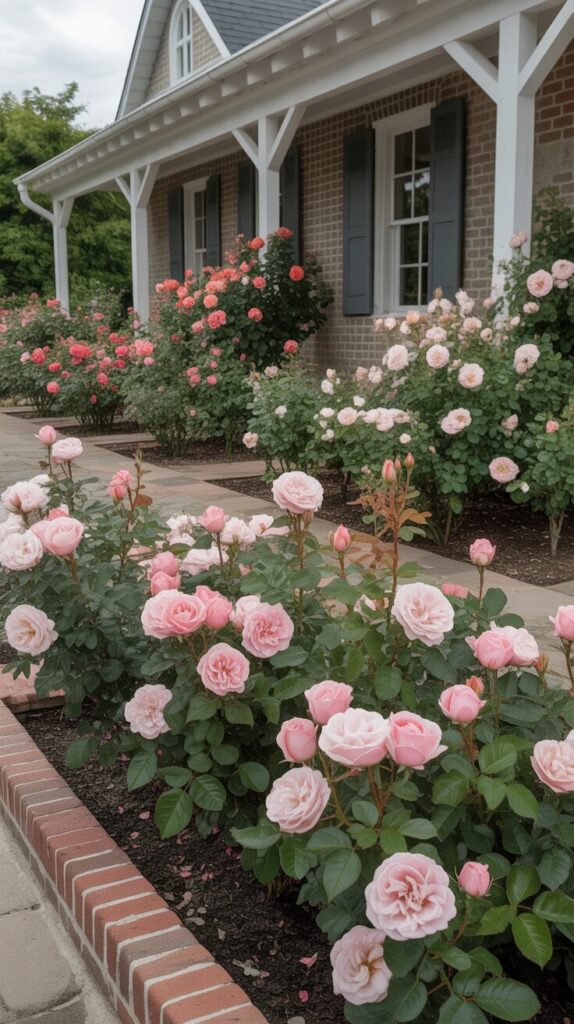
Plant shrub roses, knock-out roses, or landscape roses along your foundation for continuous summer blooms, romantic fragrance, and classic cottage garden charm that softens architectural lines beautifully and fragrantly. Modern landscape roses require far less maintenance than traditional tea roses while providing abundant color, disease resistance, and repeat blooming from spring through fall without constant deadheading or spraying. Choose colors complementing your home’s exterior—perhaps pink roses with gray siding, white roses with brick, or coral roses against stone for coordinated color schemes that appear intentional and designed. Space roses 3-4 feet apart allowing air circulation that prevents disease while ensuring they grow together creating continuous color mass rather than isolated individual plants appearing scattered and disconnected. Rose foundation plantings work wonderfully with cottage, Victorian, farmhouse, or romantic architectural styles where their soft blooms and informal growth habit complement the home’s character and historic charm authentically.
8. Variegated Foliage for Brightness
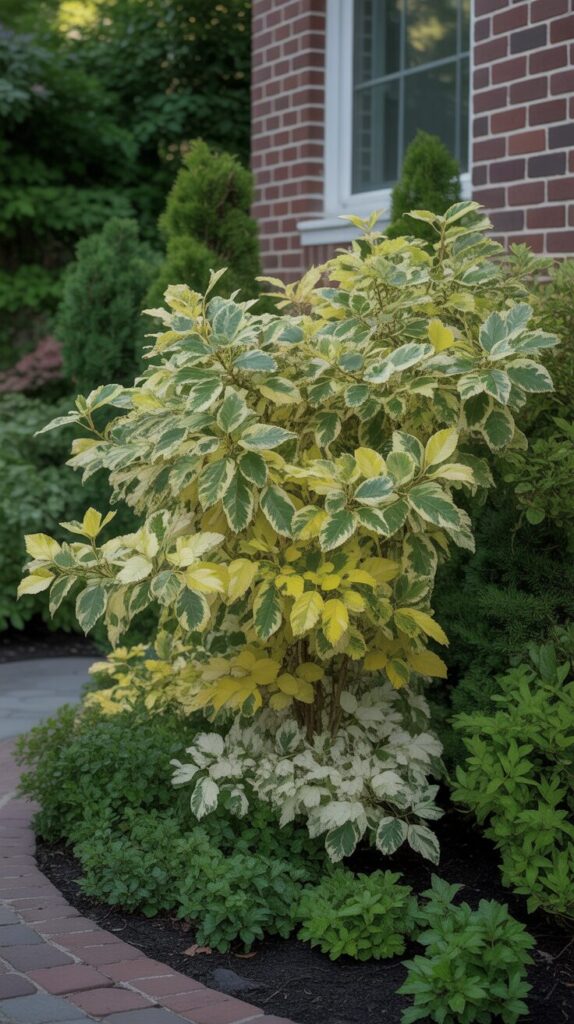
Choose shrubs with variegated leaves featuring white, cream, or yellow markings that brighten shady foundations and provide visual interest even when plants aren’t blooming throughout the growing season consistently. Varieties like variegated dogwood, variegated weigela, or euonymus offer colorful foliage that creates the effect of dappled sunlight, making dark foundations appear brighter and more welcoming to visitors approaching your home. The lighter leaf portions reflect more light than solid green foliage, creating illuminating effect particularly valuable in shaded north-facing foundation beds that otherwise appear dark and gloomy throughout the day. Plant variegated shrubs as accent pieces among solid green foundation plantings, using them strategically to draw attention to entryways, corners, or architectural features you want to emphasize and highlight. This brightening technique works with any architectural style, providing practical solution for challenging shady conditions while adding sophisticated color variation beyond typical all-green foundation plantings that can appear monotonous.
9. Layered Height Progression
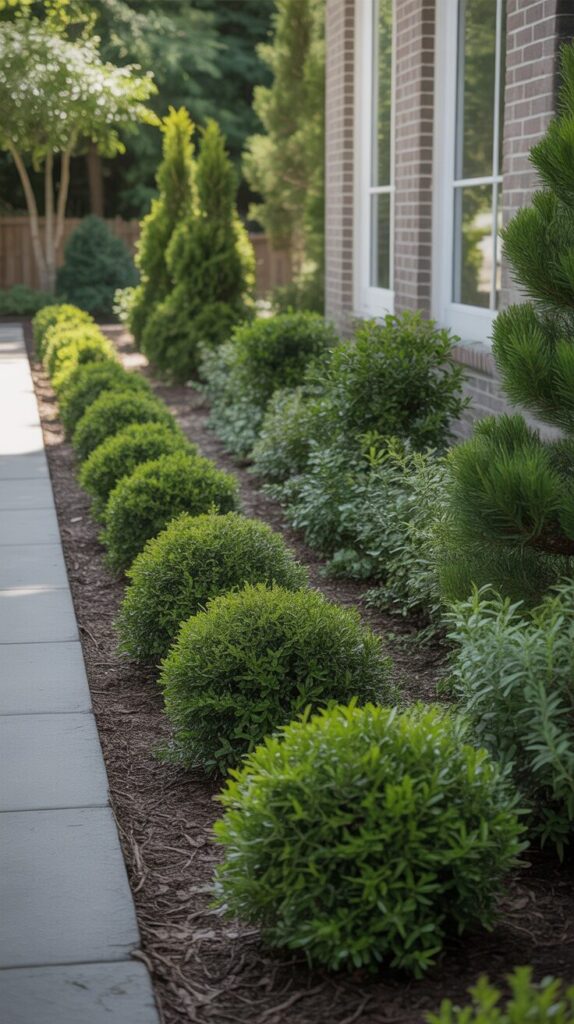
Create professional landscape design by planting bushes in graduated heights—low groundcovers nearest the house, medium shrubs in the middle, and taller specimens toward the outer edge creating natural-looking progression. This layering technique mimics how plants grow naturally in woodland edges, creating depth and dimensional interest rather than the flat, uniform appearance of single-height foundation plantings everyone else has. Start with 12-18 inch groundcovers directly against foundation, plant 2-4 foot shrubs in front of those, then position 4-6 foot taller shrubs or small trees at the border creating tiered effect. The layered approach allows you to incorporate multiple plant types, extend blooming seasons by including plants flowering at different times, and create lush, full appearance rather than sparse, newly-planted look. This sophisticated design principle works with any architectural style, creating professional-quality landscapes that appear mature and intentionally designed rather than random plantings selected without overall vision or planning involved.
10. Native Plant Selections
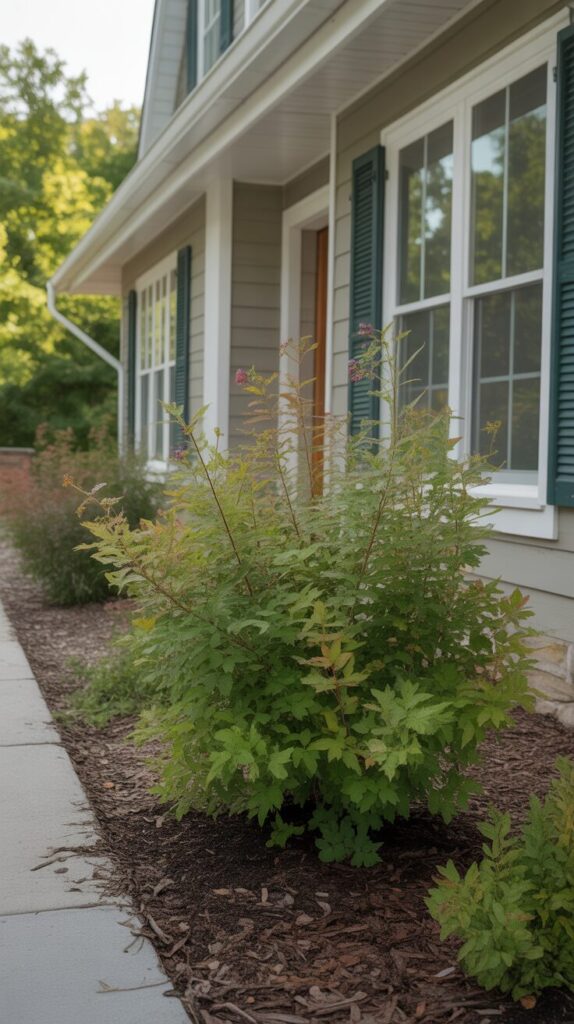
Choose native shrubs adapted to your region’s climate, soil, and conditions requiring less water, fewer pesticides, and minimal maintenance while supporting local wildlife and ecosystem health beneficially and sustainably. Native alternatives exist for most common landscape shrubs—native viburnums instead of exotic varieties, native sumacs for fall color, or native serviceberry for spring flowers and edible berries attracting birds. These regionally appropriate plants establish faster, require less ongoing care, resist local pests and diseases better than exotic imports, and support pollinators and wildlife creating living ecosystems rather than sterile landscapes. Research native options through local extension services, native plant societies, or specialized nurseries that can recommend species thriving naturally in your specific area’s conditions without extensive amendments or care. Native foundation plantings complement any architectural style while demonstrating environmental stewardship and reducing landscape maintenance time, water consumption, and chemical inputs that harm beneficial insects and pollinators essential to garden health.
11. Evergreen and Deciduous Mix
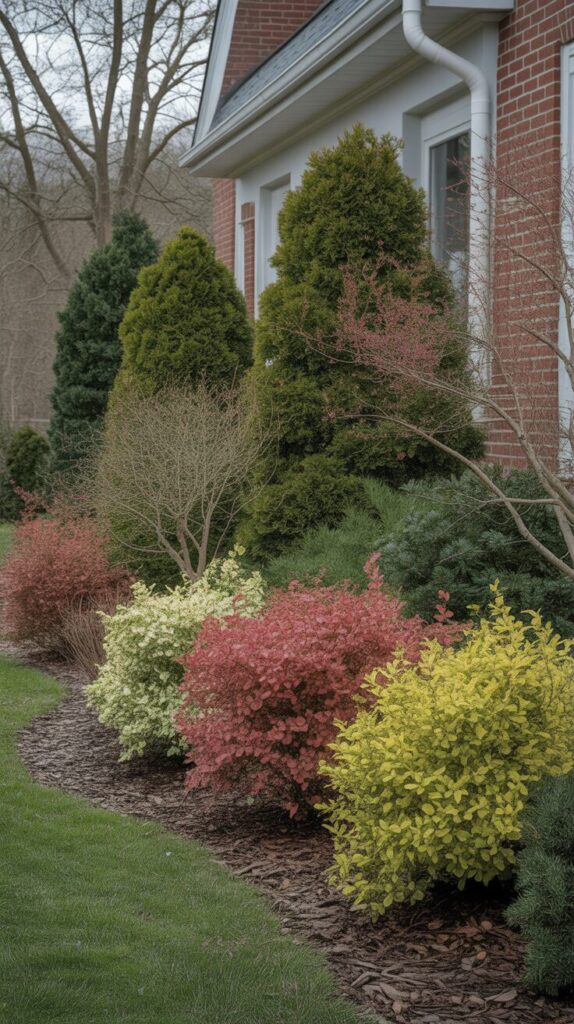
Combine evergreen shrubs providing year-round structure with deciduous varieties offering seasonal color changes, creating dynamic foundation plantings that transform throughout the year rather than appearing static and unchanging constantly. Use evergreens like boxwood, yew, or holly as backbone providing winter interest and structure, then intersperse flowering deciduous shrubs like spirea, weigela, or forsythia for spring and summer color displays. The mixed approach ensures your foundation never looks bare during winter when deciduous plants lose leaves, while the seasonal changes keep your landscape interesting throughout the year rather than monotonous. Plan carefully so the deciduous plants’ bare winter branches don’t detract from overall appearance—position them where the evergreen backdrop minimizes their dormant-season visibility or choose varieties with interesting bark or branching structure. This balanced approach works with any architectural style, creating sophisticated landscapes that provide constant interest while accommodating homeowners’ desires for both permanent structure and seasonal change that marks time’s passage and celebrates nature’s cycles.
Conclusion
These eleven ideas for bushes in front of your house demonstrate that thoughtful foundation plantings dramatically improve curb appeal, increase property value, and create welcoming first impressions that reflect well on homeowners’ pride and attention to detail. The key to successful foundation landscaping lies in selecting appropriate plants for your climate, sun exposure, and maintenance abilities while ensuring mature sizes suit the scale of your home and won’t require constant pruning. When choosing bushes for your front yard, consider year-round appearance, including winter interest, seasonal color, mature height and spread, and how different plants work together creating cohesive design rather than random collection of unrelated specimens. Remember that foundation plantings should enhance rather than hide your home’s architecture, drawing attention to attractive features while softening less appealing elements through strategic placement and thoughtful selection throughout the process. Whether you choose classic boxwood hedges, colorful hydrangeas, low-maintenance junipers, or sophisticated layered plantings mixing multiple varieties, commit to proper planting techniques, appropriate spacing, and ongoing maintenance that keeps your foundation bushes healthy and beautiful. Your home’s foundation plantings create the crucial first impression that welcomes visitors, frames your architecture, and demonstrates the care and attention you invest in your property, making these landscape choices some of the most important design decisions impacting your home’s exterior appearance.

